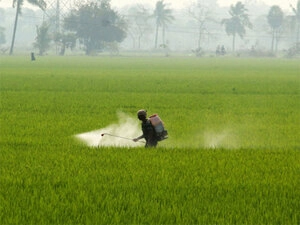

The most widely known organochlorine pesticide is dichlorodiphenyltrichloroethane, i.e., the insecticide DDT, the uncontrolled use of which raised many environmental and human health issues ( 2, 48, 49).

The important health effects, as discussed below, reveal the urgent need for implementing alternative solutions. More emphasis is given to the widely used herbicide “glyphosate,” which is an organophosphate pesticide very closely related to current agriculture ( 47). Given the fact that the health effects have been extensively discussed in the current literature, this paper focuses on the major chronic health effects and recent findings regarding health effects that have been associated with exposure to common classes of chemical pesticides, i.e., organochlorines, organophosphates, carbamates, pyrethroids, triazines, and neonicotinoids. This current review aims at highlighting the urgent need for a new concept in agriculture involving a drastic reduction in the use of chemical pesticides. Pesticides residues have also been detected in human breast milk samples, and there are concerns about prenatal exposure and health effects in children ( 13, 44– 46). However, these “safe limits” may underestimate the real health risk as in the case of simultaneous exposure to two or more chemical substances, which occurs in real-life conditions and may have synergistic effects ( 1, 43). In the majority of cases, the concentrations do not exceed the legislatively determined safe levels ( 36, 39, 41, 42). Furthermore, it should be noted that washing and peeling cannot completely remove the residues ( 40). Residues of pesticides can be found in a great variety of everyday foods and beverages, including for instance cooked meals, water, wine, fruit juices, refreshments, and animal feeds ( 32– 39). Furthermore, high occupational, accidental, or intentional exposure to pesticides can result in hospitalization and death ( 1, 31). The numerous negative health effects that have been associated with chemical pesticides include, among other effects, dermatological, gastrointestinal, neurological, carcinogenic, respiratory, reproductive, and endocrine effects ( 1, 2, 8, 10, 14– 30). Within a human or animal body, pesticides may be metabolized, excreted, stored, or bioaccumulated in body fat ( 1, 2, 13). The type of pesticide, the duration and route of exposure, and the individual health status (e.g., nutritional deficiencies and healthy/damaged skin) are determining factors in the possible health outcome. Exposure to pesticides can be through contact with the skin, ingestion, or inhalation. Many of the pesticides have been associated with health and environmental issues ( 1, 2, 7– 12), and the agricultural use of certain pesticides has been abandoned ( 2). Furthermore, there are other less known applications of these chemical substances, such as in pet shampoos ( 4), building materials, and boat bottoms in order to eliminate or prevent the presence of unwanted species ( 6). These products are also used for other purposes, such as the improvement and maintenance of non-agricultural areas like public urban green areas and sport fields ( 4, 5). Insecticides, fungicides, herbicides, rodenticides, and plant growth regulators are typical examples ( 1– 3). Pesticides are substances or mixtures of substances that are mainly used in agriculture or in public health protection programs in order to protect plants from pests, weeds or diseases, and humans from vector-borne diseases, such as malaria, dengue fever, and schistosomiasis. It is more obvious than ever that the society needs the implementation of a new agricultural concept regarding food production, which is safer for man and the environment, and to this end, steps such as the declaration of Nyéléni have been taken. The urgent need for a more sustainable and ecological approach has produced many innovative ideas, among them agriculture reforms and food production implementing sustainable practice evolving to food sovereignty. However, due to their known ability to cause a large number of negative health and environmental effects, their side effects can be an important environmental health risk factor. Pesticides are agrochemicals used in agricultural lands, public health programs, and urban green areas in order to protect plants and humans from various diseases. The industrialization of the agricultural sector has increased the chemical burden on natural ecosystems. 2Vlaamse Instelling voor Technologisch Onderzoek (VITO), Mol, Belgium.1Department of Pathology, School of Medicine, National and Kapodistrian University of Athens, Athens, Greece.


 0 kommentar(er)
0 kommentar(er)
